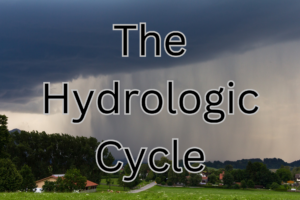The hydrologic cycle plays an important role in maintaining water balance on earth and supporting life on the earth. In this article, we will cover the whole process of the hydrologic cycle.
The Hydrologic Cycle

The processes of the hydrologic cycle are given below.
- Evaporation and Transpiration
- Condensation
- Precipitation
- RonOff
Evaporation and Transpiration :
Water evaporates from surfaces of earth such as rivers, lakes, oceans and moist soil etc. this water converts into water vapour.
The water vapour is transported over the land by the air and forms the clouds.
Water evaporating from leaves of plants through fine pores is known as transpiration. So, the overall evaporation covers surface evaporation and transpiration.
Condensation
When water vapour converts into liquid water is known as condensation. As the water vapour rises, it cools because of lower temperature and air pressure, forming fine water droplets, which make up clouds.
Precipitation
As clouds continue to develop in the atmosphere, the water droplets within clouds go through a process which is known as collision and coalescence. In this process, the fine water droplets combine and form larger droplets.
Afterall, larger water droplets fall under gravity force from clouds to the surface of earth. This falling of water droplets from clouds is called precipitation. Precipitation can be divided into two forms.
- Liquid Precipitation
- Frozen Precipitation
Liquid Precipitation
This is the most common form of precipitation to reach the surface of earth. For example, Rain. Rainfall happens when the temperature remains above freezing point throughout the formation of water drops.
Frozen Precipitation :
Frozen Precipitation consists of
- Snow : In cold weather conditions, the crystals reach the surface as frozen particles. This frozen form of precipitation is known as snow.
- Hailstone : In cold weather conditions, like thunderstorms, precipitation can take the shape of hail.
- Sleet : in cold weather conditions, the temperature below the freezing point at some levels of the atmosphere. In these conditions, the drop of water converts into ice crystals while still in the cloud.
When these ice crystals fall towards ground under gravity. They pass through the warm air of the atmosphere and fall in the form of sleet on the surface of earth.
RunOff :
RunOff includes the portion of precipitation that does not go through evaporation. When rainfall falls on the earth surface, some of the part evaporates from earth’s surface and transpiration from plants and remaining portion of precipitation is known as RunOff. This RunOff flows below the ground and above the ground and merges into oceans. Additionally, RunOff can be divided into following categories.
- Surface RunOff : Surface runoff happens when precipitation exceeds soil absorption capacity. Surface RunOff flows above the surface of earth, collecting in rivers, streams and natural channels. It is affected by intensity of rainfall, types of soil, land cover and natural and artificial drainage system.
- Subsurface RunOff : Subsurface runoff is defined as interflow above the ground water table through the soil layer.
- Base flow : Base flow is groundwater flow that is seeping into rivers and streams.
- Overland Flow : when intensity of rainfall is high and infiltration capacity of soil is low, resulting in water flowing over the surface is known as overland flow.
- Channel Flow : channel flow is movement of water above the ground level in the form of rivers or streams.
Conclusion :
Overall, the hydrologic cycle can be defined by the following formula.
Precipitation = Evaporation + Runoff
Refference :
- Punima B., Lal. Pade B.B, Jain Ashok Kumar & Jain Arun Kumar (2009). Irrigation and Water Power Engineering. Laxmi Publication (P) Ltd.